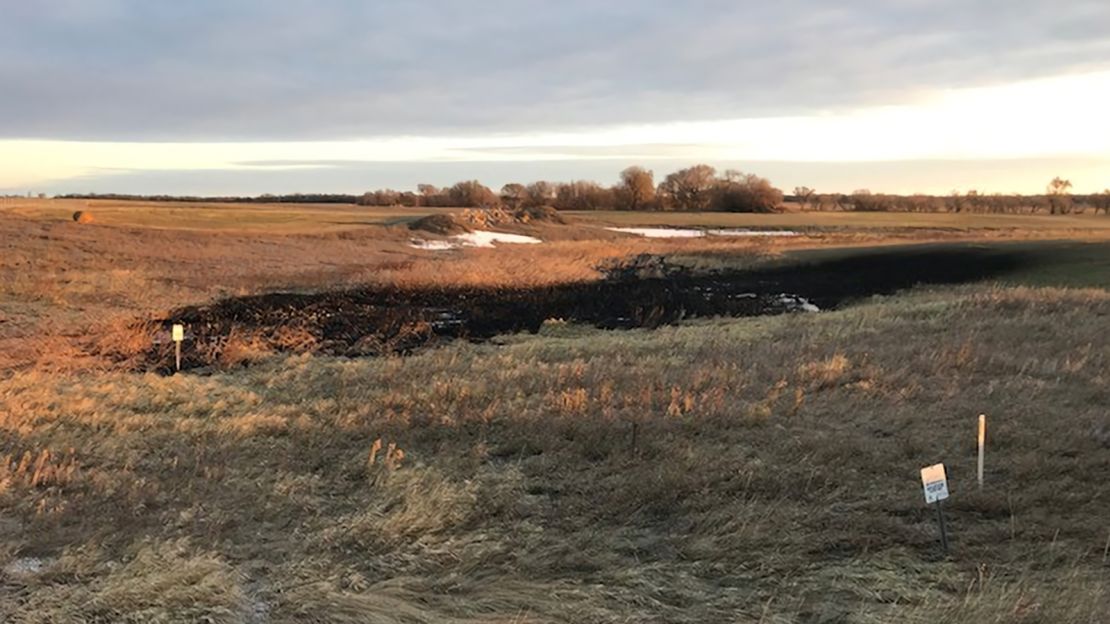The amount of land impacted by an oil spill in North Dakota is almost 10 times larger than initially reported, officials say. The disclosure comes about a month after the Keystone 1 Pipeline leaked about 383,040 gallons of oil.
TC Energy, the company that owns the pipeline, shut down it down on October 29 after discovering that the oil had leaked from the pipe into the surrounding wetlands. The pipeline was returned to service on November 10 following approval by the US Pipeline and Hazardous Materials Safety Administration, TC Energy says.
Initial reports of the leak released by TC Energy and North Dakota’s Department of Environmental Quality estimated about 2,500 square yards of land were affected by the spill.
Now, they have both revised the size of the impacted area to 4.8 acres, or 23,232 square yards – that’s almost ten times the original estimate.

The new estimate includes both the surface and subsurface impact of the leak. The initial 2,500-square-yard estimate was based on visual observations alone, the company told CNN.
“During our initial response to the incident, we immediately sectioned off a larger area (approx. 25,000 square yards) around the visibly impacted section to secure the area, provide for wildlife deterrent and air monitoring purposes,” a TC Energy representative told CNN in an email.
Despite this initial identification of 25,000 square yards to be blocked off, TC Energy did not update their website to reflect this number until Tuesday – after media reports of the large increase in impact estimates were released.
A FAQ there now reads: “Has the impacted area of the spill increased?”
“No, the impacted area has not increased beyond the original containment effort established on the day of the incident which was approximately 4.8 acres. The initial estimate of 2,500 square yards was based on the most prominently visible area. As noted in our October 31 update, the initial size estimate was ‘roughly half a football field.’ That area was closest to the pipeline area itself.”
“This is exactly the kind of spill we are worried about when it comes to Keystone XL being built. It has never been if a pipeline breaks, but rather when,” Joye Braun, Indigenous Environmental Network frontline community organizer told CNN at the time of the leak.
The Department of Environmental Quality told CNN that an estimated 8,037 barrels of oil has been recovered out of the 9,120 spilled.
The Keystone 1 Pipeline system extends 2,600 miles from Alberta, Canada, east into Manitoba, and then south to Texas, according to TC Energy.
TC Energy’s controversial pipelines
“It’s not a singular leak. Look at the history,” said Kandi White, a Native Energy and Climate Campaign Coordinator with the Indigenous Environmental Network.
TC’s most notable leak occurred in 2017 after about 210,000 gallons of oil leaked from the Keystone Pipeline in South Dakota, prompting monthslong protests which drew up to 10,000 people at there peak.
The company’s Keystone XL Pipeline would extend the pipe system, beginning in Alberta and ending in Nebraska, cutting through Montana and South Dakota.
Environmental groups oppose the expansion, arguing that the pipeline supports extraction of crude oil from oil sands, a method which releases 17% more greenhouse gasses than other extraction techniques. The pipeline would also cut across the Ogallala Aquifer, one of the world’s largest underground deposits of fresh water.
The oil transported through the Keystone pipeline is thicker and stickier than traditional oil, requiring it to be combined with hazardous materials to transfer it through the pipeline and making it more difficult to clean up.
Native American groups have also objected, arguing that the pipeline would cross through their sovereign lands.
President Donald Trump signed an order approving construction of the Keystone XL pipeline in March. The company plans to begin construction in 2020.
CORRECTION: The headline on this story has been corrected to reflect that the latest oil leak is almost 10 times worse than initially thought.
